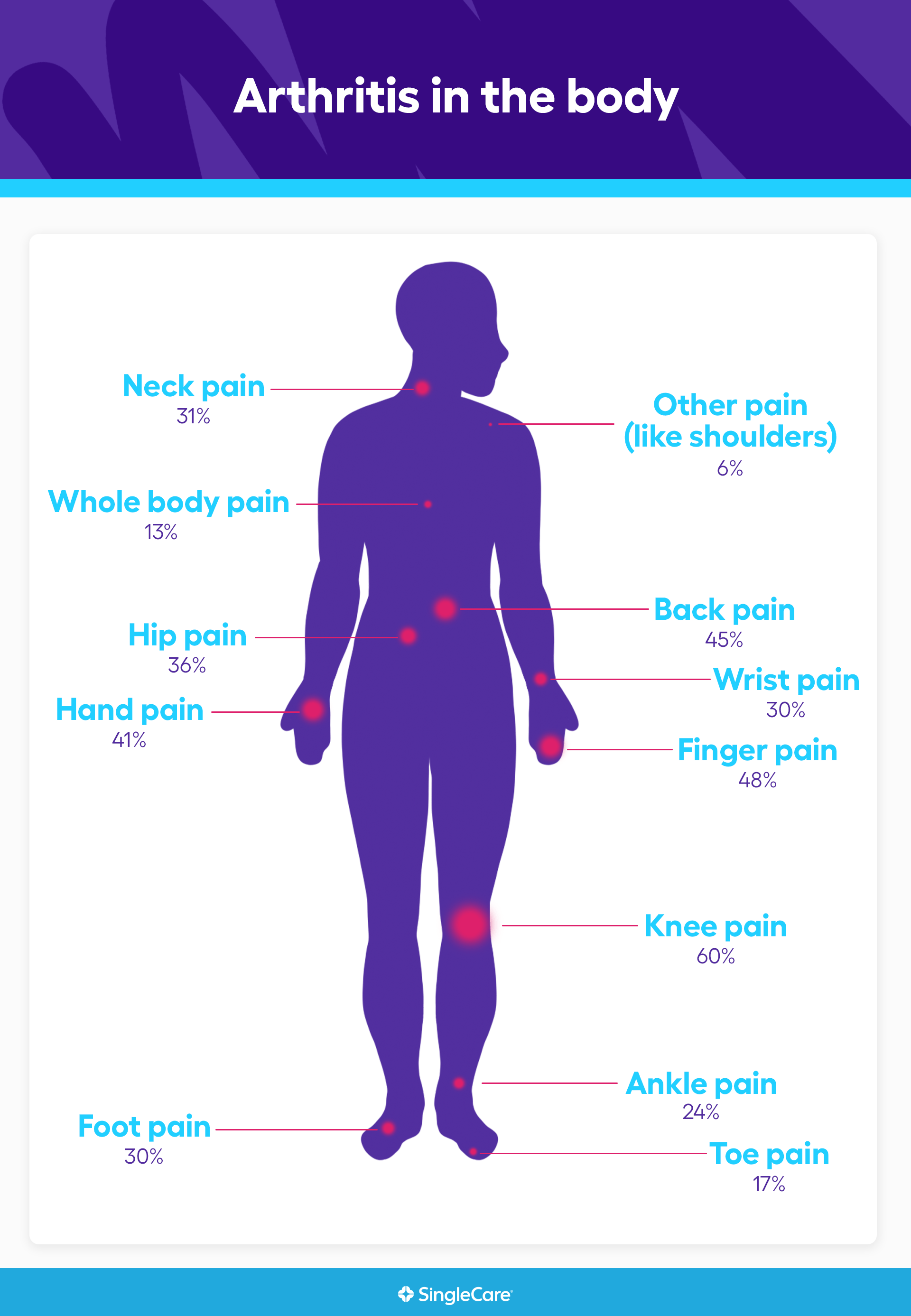Arthritis is more than just “wear and tear” or a sign of getting older. The term is often used to describe a single health condition, but there are actually more than 100 types of arthritis and related conditions. The Arthritis Foundation explains that arthritis is actually a term to refer to joint pain or joint disease.
Arthritis-related conditions affect people of all ages to various degrees. For some, symptoms are mild and they come and go. Others experience debilitating pain that makes everyday tasks—such as walking or climbing stairs—a challenge.
There’s no cure for arthritis or even a universal treatment. Rather, people with arthritis often have to test and implement lifestyle changes with several medications and therapies to find relief, which can be expensive. In 2013, the CDC estimated that arthritis costs $2,117 per adult. For National Arthritis Awareness Month, SingleCare conducted a survey of 2,000 adults to get updated arthritis statistics and learn more about how arthritis is affecting Americans’ lives and wallets.
Key findings of our arthritis survey:
- 32% have arthritis. Osteoarthritis is the most common type of arthritis.
- 15% don’t know the cause of their arthritis.
- 87% report pain from arthritis; one-third have difficulty walking.
- Knees, fingers, and back are the most commonly affected areas among respondents.
- 82% report mild to moderate pain from arthritis.
- 88% say arthritis affects their quality of life.
- 88% take arthritis medication.
- 22% have not tried any other arthritis treatments or assistive devices.
- 26% spend more than $600 per year on arthritis medications and treatments.
- Only half receive insurance or Medicare coverage for arthritis care
32% have arthritis
Of the 2,000 adults we surveyed, 32% reportedly have arthritis. Osteoarthritis is the most common form of arthritis, according to the Centers for Disease Control and Prevention (CDC) as well as our arthritis survey:
- 18% have osteoarthritis
- 8% have rheumatoid arthritis
- 3% have gout
- 2% reported other forms of arthritis (i.e., ankylosing spondylitis, degenerative arthritis, arthritis from injuries)
- 2% have psoriatic arthritis
- 1% have spondyloarthropathies
- <1% have reactive arthritis
- <1% have lupus erythematosus
- <1% have juvenile arthritis
- <1% have infectious arthritis
Osteoarthritis is caused by a breakdown of cartilage that protects our bones. Symptoms include pain, stiffness, loss of flexibility, bone spurs, and swelling. Although it’s unclear why, women are more likely to develop osteoarthritis. In our arthritis survey, 21% of female respondents reported having osteoarthritis compared to 13% of men. However, other types of arthritis were more commonly reported by males.
| Arthritis statistics in males and females | ||
|---|---|---|
| Females | Males | |
| Osteoarthritis | 21% | 13% |
| Rheumatoid arthritis | 7% | 10% |
| Gout | 2% | 5% |
| Reactive arthritis | <1% | 2% |
| Juvenile arthritis | <1% | 1% |
RELATED: Osteoarthritis vs. rheumatoid arthritis
15% don’t know the cause of their arthritis
Of the respondents with arthritis, 15% reportedly don’t know what causes their condition. Age, family history, and previous injury were the most commonly reported causes among survey takers.
- 47% believe age is the cause of their arthritis
- 45% believe family history is the cause of their arthritis
- 31% believe a previous joint injury is the cause of their arthritis
- 26% believe overweight/obesity is the cause of their arthritis
- 15% don’t know the cause of their arthritis
- 11% reported other causes of arthritis (i.e., comorbidities, working environments, weight lifting, stress, diet, and lack of exercise)
- 5% believe their sex is the cause of their arthritis
- 1% reported none of the listed causes
The National Institute of Arthritis and Musculoskeletal and Skin Diseases (NIAMS) reports that there are likely many genes that put people at risk for arthritis and that injuries and viruses can often trigger the condition. To diagnose arthritis, a general practitioner or rheumatologist will often ask about the patient’s family history, perform a physical exam, run lab tests, and request X-rays.
87% report pain from arthritis; one-third have difficulty walking
According to our survey, 99% of respondents with arthritis have symptoms. Pain, stiffness, swelling, and reduced range of motion were not only the most common symptoms reported in our survey, but they’re also the top warning signs of arthritis, according to the Arthritis Foundation.
- 87% experience pain
- 78% experience stiffness
- 50% experience swelling
- 46% experience reduced range of motion
- 38% experience difficulty walking
- 35% experience fatigue
- 29% experience malaise
- 28% experience muscle weakness
- 15% experience physical deformities, bumps, bony outgrowths
- 12% experience redness
- 1% are asymptomatic
- 1% reported other arthritis symptoms, such as popping or cracking from joints
Knees, fingers, and back are the most commonly affected areas among respondents
Arthritis can affect any part of the body where two or more bones come together. Different types of arthritis affect different parts of the body. For example, osteoarthritis commonly affects the joints in the hands, knees, hips, and spine whereas gout typically affects the big toe.
- 60% have knee pain
- 48% have finger pain
- 45% have back pain
- 41% have hand pain
- 36% have hip pain
- 31% have neck pain
- 30% have wrist pain
- 30% have foot pain
- 24% have ankle pain
- 17% have toe pain
- 13% have whole-body pain (including all or most joints)
- 6% reported other painful areas, like in the shoulders
- <1% reported none of the above
Arthritis can also cause or be the result of other health conditions. The CDC reports that 49% of adults with heart disease also had arthritis, 47% with diabetes also had arthritis, and 31% with obesity also had arthritis. For all of these conditions, the CDC and other health organizations recommend increasing physical activity, which can be difficult to do when you’re in pain.
82% report mild to moderate pain from arthritis
All but 2% of survey respondents reported some degree of pain from arthritis. One-third reported having mild pain and nearly half reported having moderate pain from arthritis.
- 8% – Severe pain
- 46% – Moderate pain
- 36% – Mild pain
- 8% – Barely any pain
- 2% – No pain at all
88% say arthritis affects their quality of life
Arthritis can affect more than someone’s physical health. Living in chronic pain and needing assistance to do daily activities can affect a person’s mental health as well. We asked survey takers how much of an impact arthritis has had on their quality of life.
- 26% – Arthritis has a significant impact on my everyday life
- 32% – Arthritis has a moderate impact on my everyday life
- 30% – Arthritis has a minimal impact on my everyday life
- 12% – Arthritis does not have a noticeable impact on my everyday life
88% take arthritis medication
There isn’t a cure for arthritis. The majority of survey respondents with arthritis report taking one or more medications for arthritis. These were the most commonly reported arthritis meds:
- 52% take analgesics (Tylenol)
- 46% take nonsteroidal anti-inflammatory drugs (ibuprofen, naproxen, diclofenac, meloxicam, celecoxib)
- 35% use menthol cream
- 31% use immunosuppressants, including corticosteroids, biologics, and/or disease-modifying antirheumatic drugs (DMARDs)
- 24% take supplements (ginger, turmeric, etc.)
- 12% take opioids
- 9% take other medications
RELATED: Is it safe to take ibuprofen and Tylenol together?
22% have not tried any other arthritis treatments or assistive devices
There isn’t a magic pill for arthritis. Lifestyle changes and therapies are often needed in addition to medication to get relief. Even diet changes can help reduce inflammation and relieve arthritis pain. Seventy-eight percent of survey takers reported using the following non-pharmacological arthritis treatments:
- 39% have tried hot and cold therapy
- 36% have tried physical therapy
- 31% have tried exercise therapy
- 21% have tried diet modifications and/or weight loss programs
- 18% have tried chiropractic care
- 18% have tried using a cane
- 16% have tried essential oils
- 10% have tried using a walker
- 9% have had surgery (joint fusion, synovectomy, knee replacement, etc.)
- 7% have tried self-management education interventions
- 7% have tried acupuncture
- 4% have tried other treatments, including wraps and braces, massage therapy, collagen, CBD (cannabidiol), and TENS (transcutaneous electrical nerve stimulation) units
- 3% have tried cognitive behavioral therapy
- 22% have not tried any other arthritis treatments
26% spend more than $600 per year on arthritis medications and treatments
Since 52% of survey respondents reported taking analgesics and 46% reported taking NSAIDs, it’s not surprising that 59% also reported spending less than $50 per month (or $600 per year). Analgesics like acetaminophen and NSAIDs like ibuprofen as well as topical creams and supplements are available in over-the-counter, generic forms. Prescriptions, surgery, and regular therapy are more expensive. For example, a one-month supply of Celebrex can cost upward of $400 without insurance.
- 59% spend less than $50 per month
- 15% spend $51-$100 per month
- 5% spend $101-$200 per month
- 2% spend $201-$300 per month
- 2% spend $301-$400 per month
- 1% spend $401-$500 per month
- <1% spend $501-$1,000 per month
- <1% spend $1,001-$1,300 per month
- <1% spend $1,301-$1,600 per month
- <1% spend $1,601-$2,000 per month
- <1% spend more than $2,000 per month
- 15% do not use arthritis medications/treatments
RELATED: Celebrex vs. ibuprofen
Only half receive insurance or Medicare coverage for arthritis care
Only 54% of survey respondents that pay for arthritis medications and treatments reported getting insurance or Medicare to cover some or all of the costs. Again, that’s most likely due to the fact that popular arthritis medications are available over the counter and therefore, not covered by insurance.
- 28% report that insurance/Medicare covers some costs
- 27% report other payment methods, including paying completely out of pocket
- 26% report that insurance/Medicare covers all costs
- 10% use prescription discount cards
- 5% use manufacturer coupons/rebates
- 3% use patient assistance programs
Those who are taking over-the-counter medications can still save money though. Ask a healthcare provider for a prescription for the OTC med, like ibuprofen, and present it to your pharmacist before you buy. With a valid prescription, you may qualify for insurance coverage but if not, you can always use a prescription discount card.
Our methodology
SingleCare conducted this arthritis survey online through AYTM on Apr. 24, 2021. This survey includes 2,000 United States adults ages 18+. Age and gender were census-balanced to match the U.S. population in age, gender, and U.S. region.







